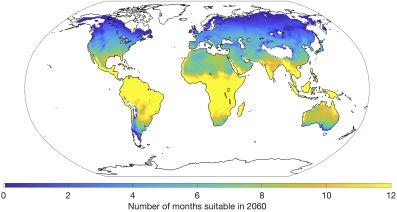Research: Before an outbreak
 Before an outbreak has started, we are interested in using mathematical models to understand where and when outbreaks are most likely to occur, enabling surveillance resources to be deployed effectively.
Before an outbreak has started, we are interested in using mathematical models to understand where and when outbreaks are most likely to occur, enabling surveillance resources to be deployed effectively.
In recent work in the group, we have been developing models to determine how the risk of outbreaks of vector-borne diseases (such as dengue and yellow fever) will vary under climate change. Other researchers have previously generated projections of future suitability for vector-borne disease accounting for two main sources of uncertainty in the future climate. Specifically, uncertainty in future societal changes (including different levels of greenhouse gas emissions) and variations in projections between different climate models have been considered. However, there is a third source of uncertainty - internal (or natural) climate variability - that refers to year-on-year variations in the climate that occur even in the absence of anthropogenic climate change. Internal climate variability is well-studied by climate scientists but is not usually considered in climate-health studies. We have therefore been generating projections of future vector-borne disease risks under climate change, accounting fully for internal climate variability, in collaboration with Prof. Jim Hurrell's climate science research group at Colorado State University.
In other research, we have been considering how surveillance for invading pathogens can be optimised. One recent project in that area considered invading pathogens of plants. We used mathematical modelling to consider optimal planting and sampling of sentinel plants (alternative host species that display visible symptoms of infection quickly). Sentinel plants can act as early warning beacons for infection, allowing new outbreaks to be identified quickly.
Publications from our group relating to this work include:
- Hart WS, Hurrell JW, Kaye AR, Chand M, Keeling MJ, Thompson RN. Climate variability amplifies the need for vector-borne disease outbreak preparedness (2025) Proc. Natl. Acad. Sci., 122:e2507311122. (Available here)
- Kaye AR, Obolski U, Sun L, Hart WS, Hurrell JW, Tildesley MJ, Thompson RN. The impact of natural climate variability on the global distribution of Aedes aegypti: a mathematical modelling study (2024) Lancet Planet. Health, 8:e1079-e1087. (Available here)
- Lovell-Read FA, Parnell S, Cunniffe NJ, Thompson RN. Using ‘sentinel’ plants to improve early detection of invasive plant pathogens (2023) PLoS Comp. Biol., 19:e1010884. (Available here)
Return to our Research page by clicking here.

